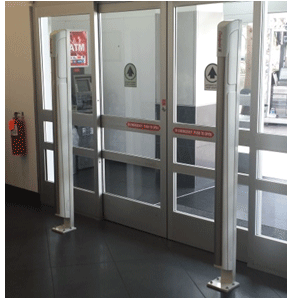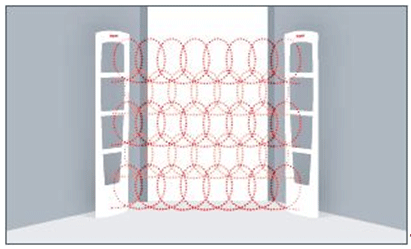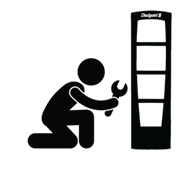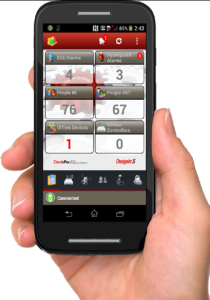Many people steal because they need the rush of the theft. Some steal because they have a mental illness, and many others steal out of necessity. The reasons of why they steal are many and varied, but the fact is that retailers big and small and consumers like you and I have to pay for the theft. Retailers make you pay a bigger price for the things you buy to counteract the money they are loosing with the shoplifting. The fact is that as a society, everybody looses. What kind of protection can you have as a store owner to prevent shoplifting in your store? Are all systems equally effective? If you have questions about loss prevention systems and what are the best ones for your business, contact us and we will be happy to talk to you.
To read more about this topics, follow the links below.
Kids used as distraction for stealing
By Victoria White
Shoplifting continues to be problematic for retailers with some people even using their children to get away with stealing goods.
Retailers said a group of adults and children went into optometrist stores in the Napier CBD last week, with adults taking items while the children were used to distract staff.
The stores realised the connection when stolen goods from one store were left at the next one hit.
At Specsavers Optometrists the group got away with three pairs of glasses.
Co-owner Mark Blades said there had been “a bit of theft of late”.
“It happens all day everyday,” he said, “it’s nothing new to me, I’ve been in retail for a long time.
“It’s unfortunate but it happens in all societies.”
Another retailer, who did not want the name of her store reported, said the group had taken $500 worth of goods from her shop.
“It was a gang of four adults and four children,” she said. “They used distracting tactics … the four kids were running around the shop and the adults were taking things, one was trying to get behind the counter.
“It was four adults using their young kids as part of the crime which is really sad.”
Staff were able to get the group’s car registration number, and identify the people for police.
ECSO starts neighborhood watch for businesses
Having alarms, locks and security grates are a good way to protect a business, but there are other ways to increase security.
One of the Escambia County Sheriff’s Office’s suggestions is involving friends and neighbors.
The ECSO has launched a free crime-prevention program for local entrepreneurs called the Business Watch. The concept is simple. It’s like a neighborhood watch, only for businesses.
Lynnea McCray of the Sheriff’s Office’s Community Services Unit said that the goal of the program is to facilitate better communication between businesses and the Sheriff’s Office, as well as share information that can help prevent and solve crimes.
“A lot of times in a neighborhood, you don’t know your neighbor but you should,” McCray should. “It’s the same with businesses. They should definitely look out for each other.”
Through the program, the Sheriff’s Office plans to create contact lists of businesses based on types and regions. So if a store owner notices someone passing counterfeit bills or shoplifting, they can quickly send out an email the Sheriff’s Office will use to notify investigators and the employers’ peers.
Police ID Walmart worker killed by shoplifting suspect; gunman on the loose
Authorities have identified the Walmart worker who they say was shot and killed by a suspected shoplifter outside of Atlanta.
Lilburn police Capt. Thomas Bardugon tells news outlets that 25-year-old Jaseramie Dion “JD” Ferguson was shot Sunday night when he and another guard approached a man who was attempting to steal three televisions from the Lilburn store.
Police released a photo of the suspect from surveillance video. They say the man fled in a red or dark red four-door sedan, leaving the TVs behind.
The Atlanta Journal-Constitution reports that Ferguson was a married father of three and had worked at the store seven months when he was shot.
The Georgia Bureau of Investigation is assisting in the probe.

 EAS is great isn’t it? For the most part, if someone is stealing product “X,” you slap on a quick tag or label and you see a pretty substantial reduction in shrink (for the most part.… Live in the real world). As my LP career has progressed over the years, I’ve seen EAS change drastically. I’ve also seen what retailers apply EAS tags to change as well. Often times, I scratch my head in disbelief at the ideas that come out sometimes and others, I pull my hair out because we could have been more proactive with tag placement. I’ve also seen some fantastic ideas from my store teams on some not so standard tagging procedures.
EAS is great isn’t it? For the most part, if someone is stealing product “X,” you slap on a quick tag or label and you see a pretty substantial reduction in shrink (for the most part.… Live in the real world). As my LP career has progressed over the years, I’ve seen EAS change drastically. I’ve also seen what retailers apply EAS tags to change as well. Often times, I scratch my head in disbelief at the ideas that come out sometimes and others, I pull my hair out because we could have been more proactive with tag placement. I’ve also seen some fantastic ideas from my store teams on some not so standard tagging procedures. Everyone I know loves a good “dumb criminal” story. In fact, I can’t go a day without someone (store managers, district managers, executives, family…) asking me to tell a crazy shoplifting story. I have a top 10 list that I usually gravitate towards, but after yesterday, I may have to change it to a top 11.
Everyone I know loves a good “dumb criminal” story. In fact, I can’t go a day without someone (store managers, district managers, executives, family…) asking me to tell a crazy shoplifting story. I have a top 10 list that I usually gravitate towards, but after yesterday, I may have to change it to a top 11.


 Tagged merchandise, metal racks, and electrical wiring in this incidental detection zone can have an adverse effect on system performance. As a general rule, tagged merchandise should be equivalent of at least ¾ of you doorway aisle width away from each EAS pedestal. Example; tags should be no closer than 4.5 feet, in a 6 foot doorway. Where possible: metal racks and electrical wiring should be 5 feet or more away from the system.
Tagged merchandise, metal racks, and electrical wiring in this incidental detection zone can have an adverse effect on system performance. As a general rule, tagged merchandise should be equivalent of at least ¾ of you doorway aisle width away from each EAS pedestal. Example; tags should be no closer than 4.5 feet, in a 6 foot doorway. Where possible: metal racks and electrical wiring should be 5 feet or more away from the system.
 In the past when managers discussed employee theft they mostly talked about the tangibles. They talked about their problems with staff stealing product, supplies and money – the physical things which can be touched and seen.
In the past when managers discussed employee theft they mostly talked about the tangibles. They talked about their problems with staff stealing product, supplies and money – the physical things which can be touched and seen.
 Burnout is an on-going, serious issue in the retail industry. The industry is so immense and pervasive that all of us, even if we’ve never working in retail, have knowledge of and experience with the problem.
Burnout is an on-going, serious issue in the retail industry. The industry is so immense and pervasive that all of us, even if we’ve never working in retail, have knowledge of and experience with the problem. I don’t care about solving social problems. I don’t care about saving the world (okay maybe I really do). But I cannot fix many of these things myself. I cannot make shoplifters change their evil trade for real work. But I can make shoplifters go somewhere else and leave my customers alone.
I don’t care about solving social problems. I don’t care about saving the world (okay maybe I really do). But I cannot fix many of these things myself. I cannot make shoplifters change their evil trade for real work. But I can make shoplifters go somewhere else and leave my customers alone. 